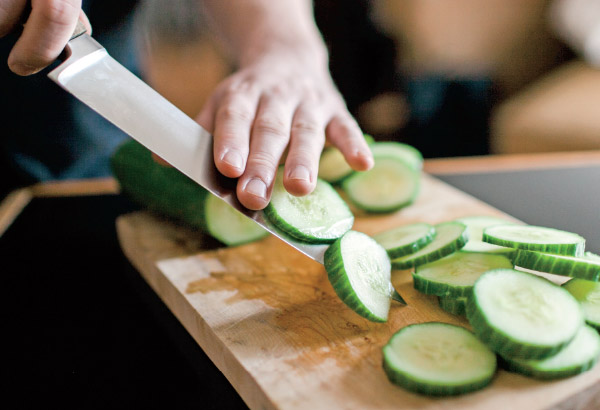
Cool as a Cucumber
With their mild, fresh flavor and crisp texture, cucumbers are a beloved kitchen staple that can be enjoyed in salads, salsas, soups and smoothies. They also have a presence in global cuisine, including traditional Mediterranean, Indian and Asian, to name a few. Here’s a closer look at the popular and versatile cucumber.
Origin: Cucumbers belong to the gourd, or curcurbitaceae, family alongside melon, squash and pumpkin. Because they grow on a vine from a flower and have seeds, they are botanically considered to be a fruit; however, we know and love them as vegetables.
Nutrient Profile: Being comprised of 95% water, cucumbers are hydrating and provide 17 calories per one-cup serving.
Nutrients provided by cucumbers include beta-carotene, potassium and vitamins C and K. They are also a source of powerful phytochemicals,
or plant nutrients, such as lutein that’s connected to vision health.
Varieties: You’ll often find two different categories of cucumbers in the produce department. While they all have a similar flavor and can be used interchangeably in most recipes, their appearance is different.
The slicing variety includes medium-length, yet stout, garden cucumbers. They have thick, smooth and dark green skin that is generally removed before eating due to its waxy texture and somewhat bitter flavor. Depending on the usage, you may also want to scoop out their large white seeds to avoid adding excess water to your recipe.
Another slicing cucumber is the English, or seedless, variety that is light green with a long, thin shape. Due to their delicate skin, English cucumbers are often wrapped in plastic for protection during transport from field to plate.
Kirby or gherkin cucumbers are great for pickling. They are vibrant green to yellow with a short, stout and bumpy appearance, and can be used for soaking in brine or eaten raw.
How to Pick and Store: When shopping, look for cucumbers that have firm, unblemished skin with no soft, mushy spots or mold. Cucumbers will remain fresh for at least a week when stored in the refrigerator, while wrapped cucumbers may last slightly longer. Avoid placing them too far back in the refrigerator as they may freeze.
In the Kitchen: The beauty of enjoying cucumbers is that there is no cooking required. Simply wash and slice or dice to add fresh flavor to chopped salads, grain bowls, chilled soups, dips, dressings, salsa, vegetable platters and more. Or experiment with an array of flavorful brines to create easy refrigerator pickles.


